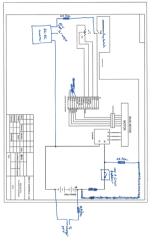Hi folks,
First post so I apologize if I've done anything wrong. I'm sure this has been addressed in another post here somewhere, but I couldn't find an answer that I could understand since I'm not all that sharp.
I'm trying to replace a controller in a Green Bee electric scooter (https://websdecode.com/greenBee/metro1). I couldn't find an exact replacement, so I've gone with Kelly's KEB72450X. I'm not trying to do anything too fancy with it, I just need it to work well enough to get me 4 miles to work and back.
I've tried to wire the controller and contactor according to Kelly's diagram (attached).
I used a 24 volt battery first. At 24 volts, the new controller power on (green light illuminated) and them motor shuddered but did not turn when the throttle was turned. At 60 volts, which is the original voltage of the scooter, I got a pretty impressive cloud of smoke from the ignition key switch when I turned the key on.
I assume this means the switch was not meant to handle 60 volts (probably obvious but I'm pretty ignorant about electric vehicles). However, in the original wiring, it looks like the key switch got 60 volts from the battery, although its very possible I missed something.
Here's the question (sorry if the intro was excessive) - I I use the 60V DC to 12V DC converter to run 12 volts through the ignition key switch and coils of the contactor, what kind of switch do I use to switch the 60V supply to the converter on and off? Have other folks come up with a good way to do this? Or do I just need an ignition key switch that can handle 60V?
Thanks! I appreciate the help, I'm probably in over my head with this project.
First post so I apologize if I've done anything wrong. I'm sure this has been addressed in another post here somewhere, but I couldn't find an answer that I could understand since I'm not all that sharp.
I'm trying to replace a controller in a Green Bee electric scooter (https://websdecode.com/greenBee/metro1). I couldn't find an exact replacement, so I've gone with Kelly's KEB72450X. I'm not trying to do anything too fancy with it, I just need it to work well enough to get me 4 miles to work and back.
I've tried to wire the controller and contactor according to Kelly's diagram (attached).
I used a 24 volt battery first. At 24 volts, the new controller power on (green light illuminated) and them motor shuddered but did not turn when the throttle was turned. At 60 volts, which is the original voltage of the scooter, I got a pretty impressive cloud of smoke from the ignition key switch when I turned the key on.
I assume this means the switch was not meant to handle 60 volts (probably obvious but I'm pretty ignorant about electric vehicles). However, in the original wiring, it looks like the key switch got 60 volts from the battery, although its very possible I missed something.
Here's the question (sorry if the intro was excessive) - I I use the 60V DC to 12V DC converter to run 12 volts through the ignition key switch and coils of the contactor, what kind of switch do I use to switch the 60V supply to the converter on and off? Have other folks come up with a good way to do this? Or do I just need an ignition key switch that can handle 60V?
Thanks! I appreciate the help, I'm probably in over my head with this project.


